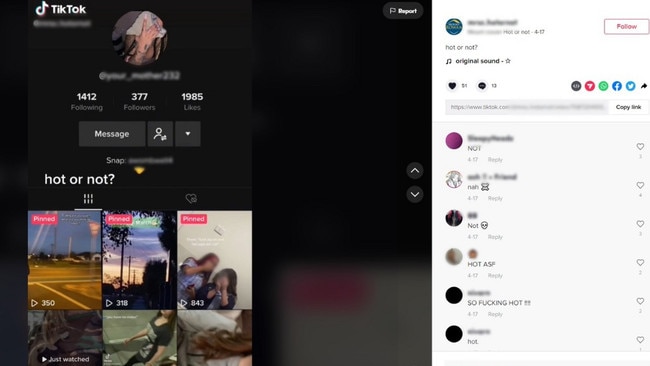Videos of Victorian students rating each other on social media slammed as bullying
Videos of Victorian teens rating their peers’ looks and personalities have been labelled as “isolating” and “damaging” as cyber-bullying reports soar.
Leader
Don't miss out on the headlines from Leader . Followed categories will be added to My News.
“Disgraceful” videos showing high school students rating each other’s looks and posting lists of who is “most annoying” have raised serious concerns about the possible mental health ramifications as cyber-bullying reports skyrocket.
The videos, posted to TikTok by students from schools across Victoria, have led to renewed calls for more effective cyber safety education.
From Ballarat to Bendigo, Melbourne, Shepparton and Warrnambool, some of the videos include photos of girls and boys ripped off social media for their peers to vote on whether they think they are “hot” or “not” in the comments.
Other videos show students “interviewing” their peers on campus and asking who they think the most attractive person at their school is.
In a cruel play on the ‘guess who’ game, Traralgon students have taken it a step further to posting “clues” for their peers to guess who the post is about.

One labels a female student “ugly”, a “crybaby” and a “teacher’s pet” as users guess who the post refers to in the comments.
Meanwhile, a video from Warrnambool includes a string of photos of students who the poster has labelled the “most annoying” at school.
A Victoria Police officer of 27 years and now cyber safety campaigner, Susan McLean, outlined serious concerns about the harm the trend could cause.
“The practice of rating particularly females based on looks or attractiveness or any other feature is disgusting and disgraceful and can have a significantly negative impact on a person‘s mental health,” she said.
“It is public humiliation, which makes the harm worse.”
While Ms McLean said the behaviour could be seen as bullying, the other serious issue she raised was privacy.

“[It] is a sad reflection on those engaging in the behaviour that they think it is acceptable,” she noted.
Many of the videos show students being “interviewed” by peers at school, while wearing their school uniforms, and identifying themselves and other students by their full names.
All TikTok videos are publicly available, meaning they can be viewed by anybody in the world.
Some of the comments and “ratings” by viewers appear to be written by men much older than the high schoolers.
Ms McLean said the first rule of cyber safety was to never include identifying information on public platforms but all of these guidelines were being broken.
She called on parents to “step up and be aware of what their kids are doing online”.
“Parents need to be an active participant in their child’s online life. Protect them and prevent them from doing harm to others.”

She said this responsibility also extended to schools, which should be providing education to prevent and discipline students engaging in “any form” of online or offline abuse and/ or bullying.
But she said there also needed to be better education in schools to prevent and discipline students engaging in “any form of online/ offline abuse and/ or bullying”.
“Platforms need to do more but those like TikTok simply do not care, despite what they say in response to an issue,” she added.
eSafety Commissioner Julie Inman Grant said content that “demeans, belittles or objectifies someone was never okay”.
“My heart goes out to any young person who feels that way because of content circulating online. Sometimes, young people may not realise how cruel, isolating and damaging this kind of content can be.”
It comes as cyber-bullying reports made to eSafety increased by 65 per cent in 2021-2022, reaching a high of 1,542 reports.
It continued the sharp increase seen since the onset of the Covid pandemic, when children and young people spent more time in front of screens.
The majority of reports concerned girls aged between 12 and 16.
“Cyber-bullying can be particularly insidious as its amplification can be very visible to one’s peers but relatively hidden to parents, carers and educators,” Ms Inman Grant said.
“We know from experience the more quickly we can remove online abuse, the more mental and emotional relief we can provide to young people who are targeted.”
The commission has powers to remove cyber-bullying content where platforms fail to do so.
“When a report is received, eSafety will determine whether the material constitutes serious cyber-bullying,” Ms Inman Grant said.
“In the course of an investigation, we may work with parents, schools and in some circumstances police.”
It has a success rate of removing 88 per cent of serious cyber-bullying material.
Ms Inman Grant said eSafety was working with the industry to improve online safety.
“Technology companies can and should do more to protect users from all kinds of harm online.
“eSafety is working with industry to raise the bar for transparency and accountability through the Online Safety Act 2021.”
A Department of Education spokesperson said Victorian schools took “strong action” in relation to bullying.
However, they added that “social media providers have a critical role to play in preventing the publication of content that promotes bullying – and we are continuing to raise this issue with the platforms directly”.
A TikTok spokesperson said the platform’s highest priority was to “maintain a safe and positive environment for everyone”.
“Our Community Guidelines make it clear that we do not tolerate content that contains bullying or harassment, statements targeting an individual, or hateful speech or behaviour, and we remove content that violates these guidelines.
“We work closely with a range of federal and state agencies, including the Office of the eSafety Commissioner, and we also have robust tools to report content and provide expert-backed anti-bullying resources and education in our Safety Centre.”
Children and young people experiencing cyber-bullying should talk to a trusted adult or call Kids Helpline on 1800 55 1800.
Visit esafety.gov.au for information, advice and to report cyber-bullying.



